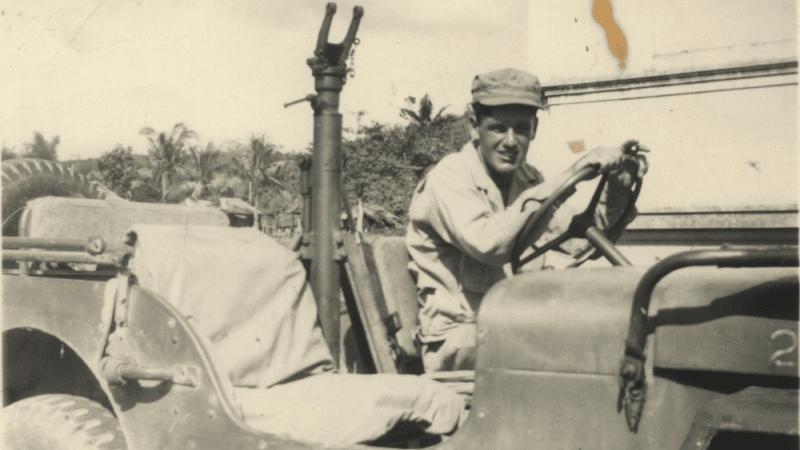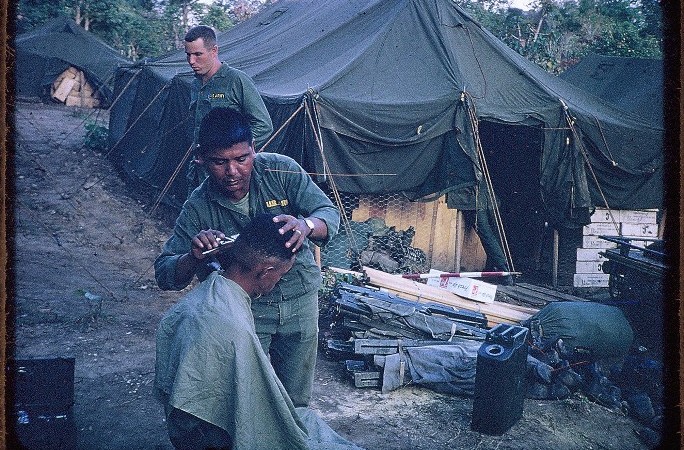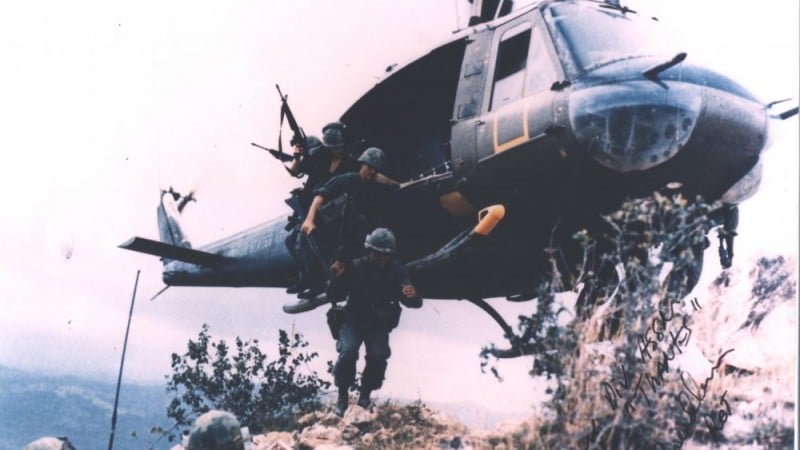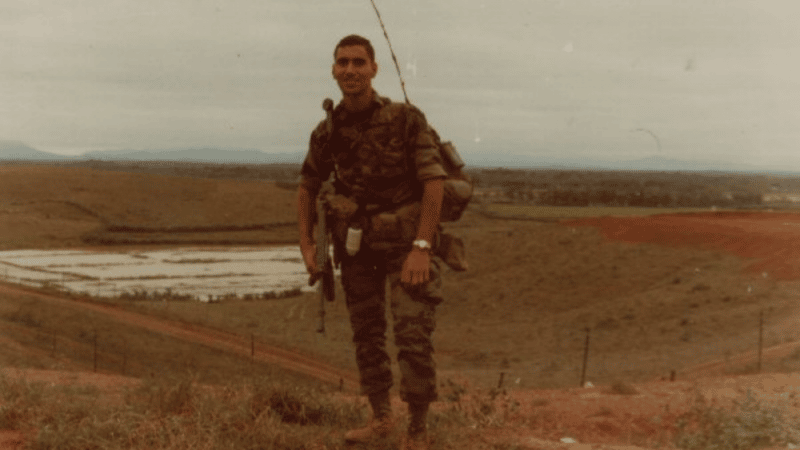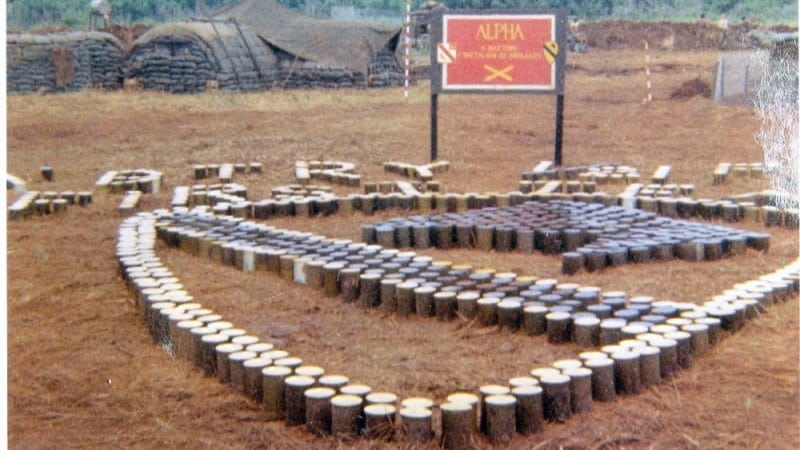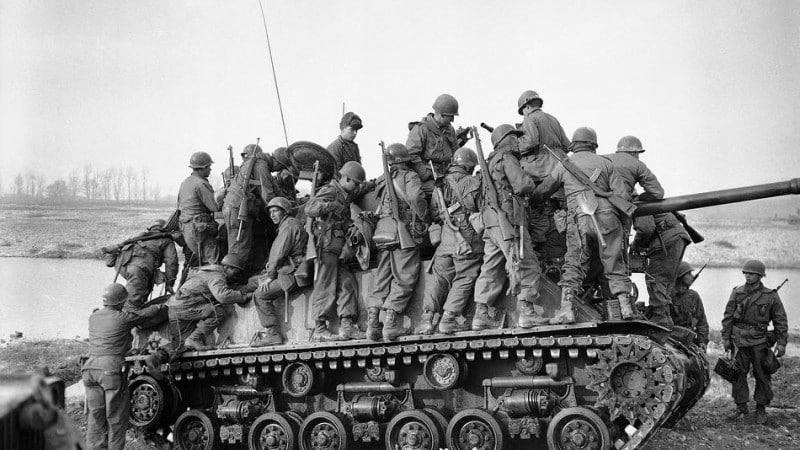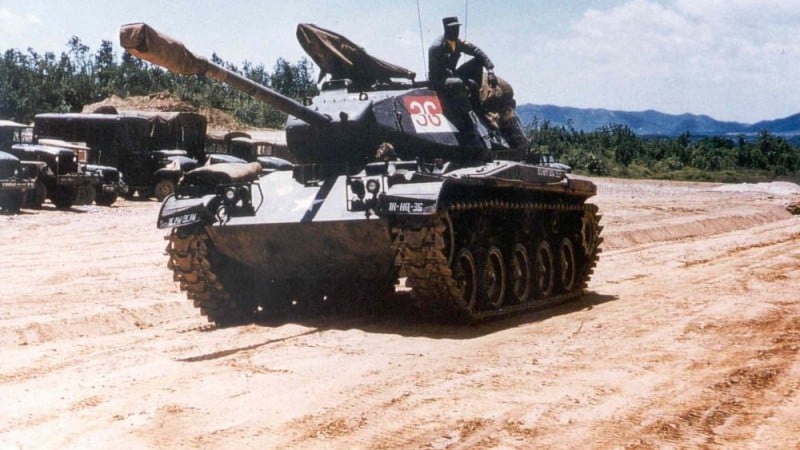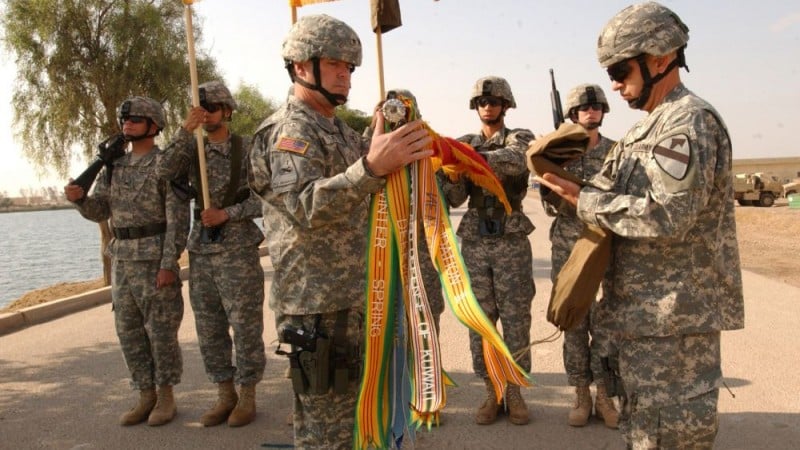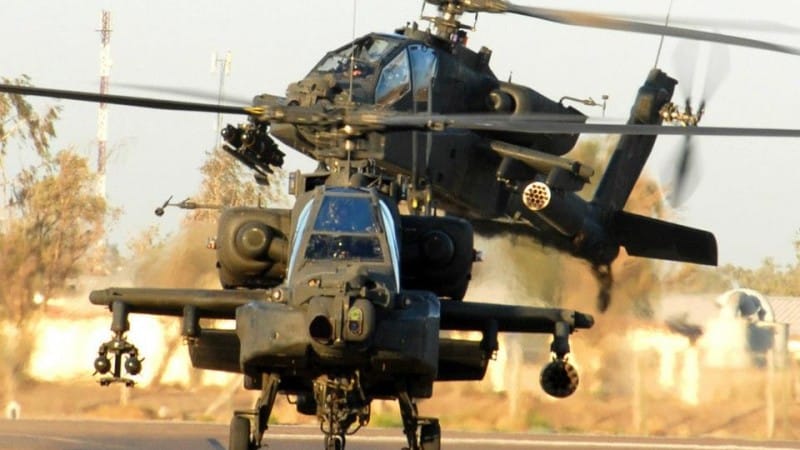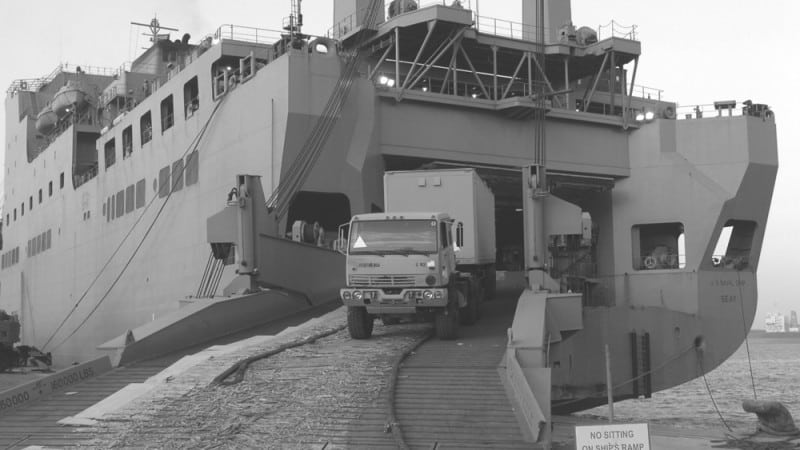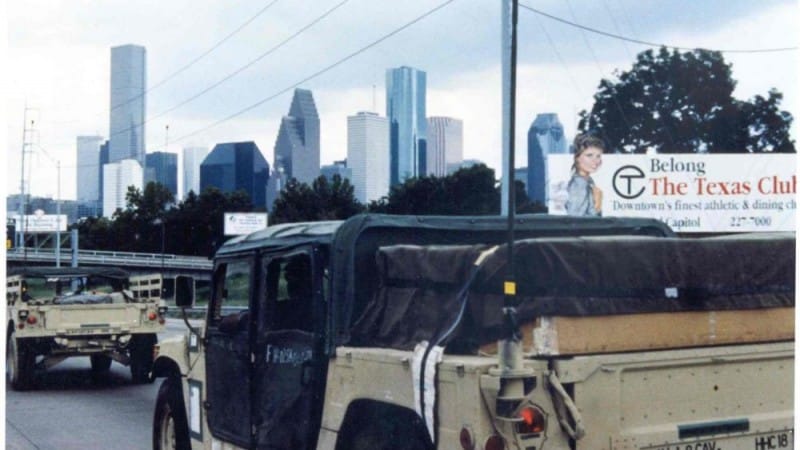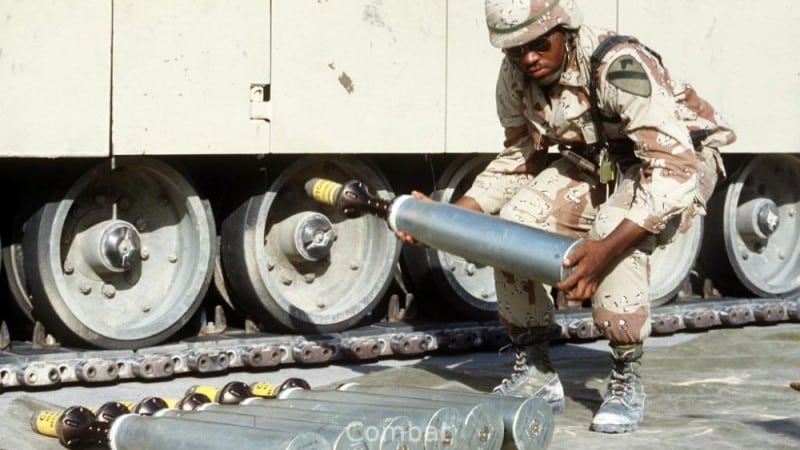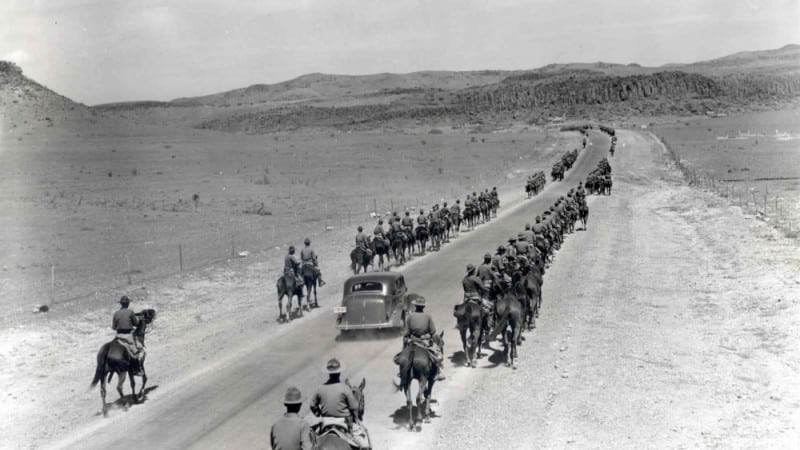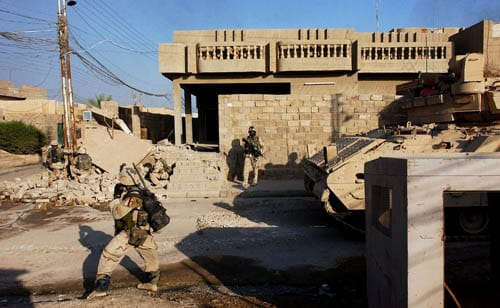4th Battalion, 5th Air Defense Artillery Battalion
A Short Range Air Defense Separate Battalion (SHORAD).
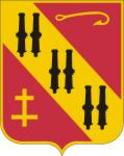
On 16 November 1988 the 4th Missile Battalion, 5th Air Defense Artillery was redesignated as the 4th Battalion, 5th Air Defense Artillery Regiment, assigned to the 1st Cavalry Division and activated at Fort Hood, Texas as a Short Range Air Defense Separate Battalion (SHORAD).
Its first training mission was to the National Training Center (NTC) at Fort Irwin, California. The effective training at the NTC could have not come at a more opportune time in the history of the battalion. Upon their return to Fort Hood, the Battalion Commander undertook the task of reorganizing and fielding the Army’s first “Avenger” Antiaircraft Battery. The “Avenger” system is a lightweight, highly mobile and transportable surface-to-air missile/gun weapon system mounted on a High Mobility Multi-Purpose Wheeled Vehicle (HMMWV).
The Avenger surface-to-air missile (SAM) system has two stinger pods called Standard Vehicle Mounted Launchers (SVMLs). Each pod is capable of carrying four ready Stinger missiles, a significant improvement over the one man – one shot concept of the Man-Portable Stinger missile system. The Avenger also mounts a .50 caliber machine gun capable of operating in an air and ground mode; a Forward-Looking Infrared system for target detection and tracking; and a laptop computer-based display for early warning and target cuing.
In the midst of the reorganization, on 7 August 1990, a deployment order for the Southwest Asia operations was issued. Plans calling for the division to deploy by 15 September extended the work day to 14, 16 and in some cases 24 hours. Since the availability of Avenger Systems prior to deployment was uncertain, and in order to maximize combat power, the Battalion quickly was reorganized back to its original configuration of 4 Batteries consisting of 27 Vulcan and 60 Stinger Teams. Along with the return to the old organization, a decision to accelerate Avenger fielding and obtain as many systems as possible prior to deployment was made. The combined efforts of the Army Procurement Sections and Boeing allowed the Battalion to rapidly field three platoons and significantly upgrade its maintenance capability to sustain systems in an immature theater by providing additional test equipment and spare parts.
War plans were developed with the basic assumption that the Division would deploy task organized and could arrive at several different ports. To meet that objective, batteries were deployed with their Brigade Headquarters and a minimum of one Stinger Section or Vulcan/Avenger Platoon on each of the thirteen ships. The plan included the front loading of the Headquarters and Headquarters Battery to provide the initial control, command and a link into Theater Air Defense Commands, as well as provide the initial short range air defense umbrella over the Sea Port of Debarkation and associated staging areas.
In the midst of all the other activities, an accelerated NTC recovery plan was accomplished and all vehicles were serviced and road tested. New 5-ton trucks were obtained and all vehicles were painted sand color by organic paint teams. Massive quantities of long needed equipment were received, including night goggles, GPS position/navigation devices, radios and installation kits and not least needed; tentage. Load plans for vehicles and containers were developed and vehicles were uploaded. Ammunition basic loads were delivered, uploaded, inspected and placed under guard.
Persian Gulf War, Southwest Asia
As ship arrival dates were confirmed, vehicles were staged for movement and received a final automotive inspection. On schedule, by mid September heavy vehicles were loaded at the Fort Hood railhead to make the trip to the seaports of Houston and Beaumont, the seaports of Embarkation. Additional vehicles formed road conveys that left every two hours, around the clock.
On 16 September, an Air Force C5A Galaxy, carrying the advanced headquarters staff, left Fort Hood Robert Gray Army Airfield. In the final drama, on 28 – 29 September, Soldiers of two batteries assembled for manifest roll call. The moment came; busses pulled up and the time for memories had begun. The other two batteries and a small “stay behind” team deployed over the next two weeks. Upon arrival at Dammon, an early warning network to alert of an impending missile or aircraft attack was immediately established.
soldiers of the battalion were housed in two separate warehouse locations and quickly went about the business of offloading ships, inventorying equipment and preparing vehicles for movement to field locations. As Vulcan Systems arrived, platoons were assigned defense missions covering ground and sea approaches into Division staging areas and Command Posts. As soon as their equipment arrived and became combat ready, the battalion began their move to Assembly Area Horse, in the desert 160 kilometers northwest of the port.
On 6 October, “B” Battery deployed its Command Post, Vulcans and Stingers to the desert with the initial elements of the 1st Cavalry Division. They provided liaison and defense support to the Assault Command Post of the Division and coordinated an ever expanding air defense umbrella over the deploying forces. On 13 October, the Battalion TAC deployed and assumed control of all air defense operations. In addition the Battalion deployed its Fire Coordination Team to the USAF Control and Reporting (CRC) at the Dhahran Air Base who maintained a direct link between the Division and all tactical, strategic and national surveillance sources in the theater.
On 23 October, the Division was ordered to move to AA Wendy, located 15 kilometers northwest of King Khalid Military City (KKMC). Its mission was to block approaches to the city and be in a position to respond to attacks down the Wadi al Batin, which is the historic approach through the tri-border area. Upon this juncture, the Battalion had to leave “B” Battery with the Tiger Brigade in AA Horse with a counter attack mission in support of XVIII Airborne Corps. The balance of the air defense platoons moved to AA Wendy with their respective supported Brigades. As the Division completed its movement west, the battalion relocated its Fire Coordination Team to a newly formed CRC at KKMC.
Due to projected terrorists and special operation forces threat, Vulcan Platoons provided continuous ground defense coverage to the three Command Posts of the Division. When all forces of the Division had deployed, by 30 October, the Battalion task reorganized providing one battery in direct support of each Brigade Battle Task Force. Throughout the occupation of AA Horse, approximately one third of all air defense weapon systems remained deployed providing continuous coverage, while others trained for combat operations.
Receiving word that the three Avenger Platoons had completed training and would arrive prior to anticipated combat, the Battalion began transitioning to the new Avenger Battalion configuration on 10 December. Freed equipment was used to create the new Delta Battery Headquarters. Throughout the transition, contingency plans existed to quickly reconfigure the displaced Stinger Teams should hostilities commence prior to the arrival of Avengers in the theater.
On 2 January, the Tiger Brigade, including “B” Battery, was attached to the 2nd Marine Division giving them a heavy armored punch required to penetrate Iraqi belts as they attacked deep into Kuwait. “B” Battery quickly integrated itself into the Marines operations and logistic systems. “B” Battery equipped themselves with early warning downlink devices which enabled the Battery Command to receive a real-time radar picture of the air combat situation. The air weapons weapon systems (2 Vulcan Platoons and 2 Stinger Sections) of the battery were integrated into the overall air defense design of the Division, allowing the Marines to reposition some of their Stinger Teams to provide a greater depth of coverage.
In January 1991, the division was attached to VII (US) Corps and the focus of the First Team clearly began to shift toward offensive action. On 14 January, in a driving rainstorm the Division was ordered to quickly move its 17,000 Soldiers under the cover of darkness to new defensive positions south of the Tapline Road. By morning, all had moved over 80 km and were in a position to protect critical logistical bases and VII Corps staging areas, as well as being in a position to quickly support the Syrians to the front and Egyptian forces to the right flank.
In the early morning of 17 January 1991, the Fire Coordination Team issued notification that 100 Tomahawk missiles had been launched and the Air Campaign had begun. The Air Defense Warning was elevated to “Yellow” and the Weapons System Control Status to “Tight”. The response of Iraq came quickly in the form of a SCUD Missile launched toward Dhahran. The Fire Coordination Team of the battalion provided an instantaneous alert of the launch and passed it on to all elements of the Division. This began many tests of the Early Warning System, which operated continuously and effectively.
On 20 January, the Avenger Platoons arrived with their equipment following on the 27th. By early February, the Battalion had all its combat power to full strength. It totaled six Vulcan Platoons, ten Stinger Sections, six Avenger Platoons and six FARR’s along with an additional sixty replacement Soldiers from Fort Bliss and various CONUS Divisions.
As the Air Campaign progressed and the VII Corps continued to build combat strength, the Division was ordered to move further north of the Tapline Road and establish a defense which was more able to block an Iraqi preemptive strike and support the Allies to the North. As the Syrian and Egyptian Forces were ordered to shift their positions to the east, the 1st Cavalry Division moved north to provide a screen along the tri border area and to ultimately portray an Allied main strike up the Wadi al Batin.
During 7-20 February, the offensive lines of the 1st Cavalry Division have crept north and are now just below the border. Both of the 1st and 2nd Brigades and supporting artillery conduct reconnaissance, artillery raids, and “Berm Buster” obstacle reduction missions.
In its final strategic position, the First Team was given the most critical mission of the entire Ground Campaign. Its threefold mission was to lure Saddam Hussein into believing the Allied attack would come occur up the Wadi al Batin, and trick him into placing additional forces there, while at the same time gather information on the organization and disposition of the enemy along with an assessment of their reaction and tactics against U.S. Forces. The First Team began its secret fight to deceive Iraq long before the world would come to know that “ground-war fighting” had already begun. The deception consisted of three major thrusts:
1. Operation Red Storm, a VII Corps Artillery-Aviation raid up the Wadi al Batin, was designed to make the Iraqis believe that the Wadi was being prepped for the main offensive. It utilized the resources of the 11th Aviation Brigade, the 1st Cavalry Division Artillery, and elements of the VII Corps Artillery. Just prior to 0100 hours, 16 February 1991, the artillery units fired a three minute prep on selected targets, followed by Apache attack helicopters crossing the Berm to engage targets of opportunity. In conjunction with this action, USAF assets attacked targets deep in Iraqi. The several aviation raids placed a unique opportunity to successfully execute detailed Army Airspace Command and Control (A2C2) procedures.
A reconnaissance in force conducted by Task Force 1-5 CAV up the Wadi al Batin to determine the strength, composition, and disposition of Iraqi forces in the area. This operation, intended to make the Iraqis think that a major attack up the Wadi al Batin was being initiated, was the first mounted combat in Iraq during the war. It was also the bloodiest battle of the war for the 1st Cavalry Division.
2. Desert Storm’s “First” major ground encounter was on 19/20 February 1991 when the division’s 2nd (Blackjack) Brigade attacked 10 miles into Iraq, confirming and destroying enemy positions. On the opening of the ground war, the Blackjack Brigade, supported by the Aviation Brigade Apache helicopters, moved into Iraq on a “reconnaissance in force”. “C” Battery placed Stinger Teams in armored vehicles in support of three company teams and employed a Section of two Vulcans and the leader of the 2nd Platoon with Alpha Company. The Brigade broke contact after penetrating enemy obstacles, taking fire and causing the enemy to light oil fire trenches. They withdrew south to join the division for the subsequent series of final attacks.
The 3rd Battalion, 82nd Field Artillery, reinforced by Battery A, 21st Field Artillery (MLRS), fired in support of the 2nd “Blackjack” Brigade’s attack up the Wadi al Batin on “G-Day”, the first day of the ground campaign. This attack was a “feint”; intended to make the Iraqis think that the coalition main attack was coming up the Wadi al Batin.
3. After thirty-eight days of continuous air attacks on targets in Iraq and Kuwait, the commander of the Allied Forces, General Norman Schwarzkopf unleashed all-out attacks against Iraqi forces very early on 24 February 1991. The 3rd Battalion, 82nd Field Artillery, reinforced by Battery “A”, 21st Field Artillery Multiple Launched Rocket Systems (MLRS) laid down heavy fire in support of the 2nd “Blackjack” Brigade’s “feint” attack up the Wadi al Batin. The Blackjack Brigade with its supporting Air Defense Artillery attacked up the Wadi al Batin and struck deep into Iraq. In heavy fighting, they penetrated Iraqi’s defense and caused the fire trenches to be lit. They withdrew south to join the division for its final attack.
This operation was an unqualified success. The enemy reacted as anticipated. Iraqi divisions focused on the coalition threat in the Wadi, and the First Team froze them. The deception worked, in that it tied down four Iraqi divisions, leaving their flanks thinned and allowed the VII Corps to attack virtually unopposed, conducting a successful envelopment of Iraqi forces to the west.
On 26 February, shortly after noon, the Division received the mission to join the VII Corps. Thus commenced the longest continuous armored movement in history. The division charged west pausing only to refuel before passing through breeches in the enemy obstacle belt. Racing north, then east, the division moved in a vast armada of armor, stretching from horizon to horizon, The 4th Battalion elements were integrated into all formations and provided continuous coverage both day and night. Effective communications were maintained despite a separation of 300 km between lead and read elements. Within 24 hours, the first Team had gone 300 kilometers, slicing deep into the enemy’s rear. As the division prepared to destroy a Republican Guard division, the cease fire halted it.
The Tiger Brigade and “B” Battery were given the mission of spearheading the attack of the 2nd Marine Division into Kuwait and securing objectives in the vicinity of al Jahrah and the International Airport to the West of Kuwait City. Bravo Battery employed Vulcan Platoons in Direct Support of lead task forces, while utilizing Stinger Sections to cover the trailing trains. Moving under an F-18 and Hawk umbrella, the penetration of the initial defensive belts was easy, but hard fighting ensued in the second defensive belt on the outskirts of the city of al Jahrah. The fighting was a combination of long range tank batteries and close-in fighting as fortified positions were breached.
Vulcan crews provided suppressive fires on the flanks of tanks and Bradley platoons, allowing them to concentrate on the direct close battle to their fronts. Vulcans destroyed numerous light armored vehicles, killed several hundred Iraqi infantry and reduced numerous bunkers to piles of broken concrete and sand. Though Bravo Battery experienced some of the hardest fighting in the Division, except for one flesh wound, they came out unharmed. On 28 February, amidst the haze of burning oil wells, the Tiger Brigade began mopping up the area and reconstituting its forces.
The Cease Fire became official at 8:00 on 28 February as the 1st Cavalry Division was poised to attack. The units of the 1st Cavalry Division setup defensive positions where the cease fire had stopped their attack, then expanded north to “Highway 8,” clearing bunkers and looking for enemy equipment and Soldiers. The 1st (Ironhorse) Brigade stretched through the historic Euphrates River Valley. The Tiger Brigade consolidated into a Brigade assembly area on the outskirts of al Jahrah and continued reconstitution operations. Within two weeks the 4th Battalion along with the 1st Cavalry Division moved south into Saudi Arabia and its new assembly area (AA) Killeen, just west of Hafar al Batin. There on the plain of the Wadi al Batin – the Cavalry began to prepare for redeployment home.
Post Gulf War
Since the war, elements of the battalion deployed to the Emirate of Kuwait twice for exercise Intrinsic Action and once for exercise Iris Gold. The Battalion led the Army as a modern heavy-division battalion with three batteries of Bradley Stinger Fighting Vehicles and one battery of Avengers.
On 15 March 1996, the 4th Battalion was designated as the Regimental Headquarters for the 5th Air Defense Regiment. The only air defense battalion within the Division, the Renegades stood ready to again deploy, fight and win with the First Team.
As one of the preparation efforts, Exercise Clear Skies I, a joint service and inter-agency operation, was conducted for three days in July, 2002 under the command of the North American Aerospace Defense Command (NORAD) and involved units from NORAD, Air Force, Navy, Army, Customs Service, Federal Aviation Administration and the Secret Service.
“Operation Clear Skies – Washington DC”
To support the mission of protecting national assets after the terrorist attacks of 11 September 2001, elements of 4th Battalion, 5th Air Defense Artillery (ADA) along with staff officers of the 32nd Army Air and Missile Defense Command (AAMDC) deployed to the National Capitol Region in early September 2002 as part of the multi-layered air defense exercise. This exercise integrated fighter and support aircraft, radar and ground-based air defense systems and communication links, including those of the Sentinel radar, Avenger Antiaircraft Missile Weapon System, and Stinger Man Portable missile systems of the 4th Battalion, 5th ADA.
On 9 September, the operation was upgraded as Operation Clear Skies II and was scheduled to end on 14 September. However, on 10 September, in response to elevated security threats, the Secretary of Defense, Rumsfeld approved the transition of the exercise into a live operation “Noble Eagle” – loading the launchers with live missiles to provide an extra layer of defense for the anniversary of the 11 September attack on the United States, which included a large outdoor ceremony at the Pentagon attended by President Bush.
On 11 September 2012, while citizens of the world contemplated the events surrounding the first anniversary of the September attacks on the United States, the Renegades of the 4th Battalion, 5th ADA Regiment, 1st Cavalry Division turned their portable short range air system, the eyes of the Sentinel and striking force of the Avenger, skyward to protect the nation’s capitol.
The urban environment required innovative solutions to issues like force protection, terrain management, and movement of personnel and visitors. Additionally the Soldiers of the 4th Battalion, 5th ADA successfully handled the extra stresses and pressures related to being a highly visible part of a high profile operation.
Many of the Washington area’s monuments are visible from the tactical Avenger and Stinger team locations and were constant reminders to the Soldiers that they are deployed here for an important reason.
On 18 September, one week after the Pentagon activated the network of antiaircraft missiles to defend Washington DC against another potential terrorist attack, the operation was evaluated as being able to meet the potential threat and the missiles were deactivated and removed. Following a debriefing, the 4th Battalion, 5th ADA returned to Fort Hood, Texas.
Building on the after action findings of the Washington DC deployment during the period of 14 to 22 November, elements of the 4th Battalion, 5th ADA participated in additional Integrated Inter Agency System Intrusion Detection and Threat Response Tests which were held in the areas surrounding Crawford, Texas.
On 7 February 2003 the Attorney General, John Ashcroft, announced the increase of the national threat level from “Yellow” to “Orange,” indicating the possibility of a “high risk of terrorist attacks.” The level was raised in part because of a high amount of “chatter” being intercepted by various intelligence agencies.
In response, elements of the 4th Battalion, 5th ADA redeployed to the national capital and by 12 February all of their equipment was in position and integrated into the defense system communications network. Since that movement, they have remained there on station, carrying out their assigned precautionary and prudent defense mission.
Despite heavy commercial and military air traffic in the immediate region, the Soldiers of 4th Battalion, 5th ADA continue to be at a high state of alert and motivation. Relying on previous training for confidence in the success of this mission, they remain composed and continue to calmly man their strategically located positions ready to respond should the situation warrant.
The battalion was deployed to Iraq along with the rest of the 1st Cavalry Division for Operation Iraqi Freedom from March 2004 to March 2005. The battalion’s mission was to provide security of key assets in “Victory North” and the Taji area of operations in Northern Baghdad and in the vicinity of the Baghdad International Airport.
After returning to Fort Hood the 4th Battalion, 5th Air Defense Artillery was relieved from assignment to the 1st Cavalry Division and assigned to the 31st Air Defense Artillery Brigade remaining at Fort Hood, Texas.
From June 2006 to July 2007, a detachment from the battalion served as the 1st Counter-Rocket Artillery and Mortar (CRAM) Sense and Warn detachment providing early warning for Multi-National Corps-Iraq again in Baghdad.
On 13 June 2008, the battalion was assigned to the 69th Air Defense Artillery Brigade. In October of 2008, the battalion began a one-year deployment to Korea providing continuous Air Missile Defense cover for the Southern area of responsibility in the Republic of Korea.
In March 2009, E Battery deployed to Iraq in support of Operation Iraqi Freedom as part of Task Force 3-3 ADA.
Information compiled and composed by William H. Boudreau
